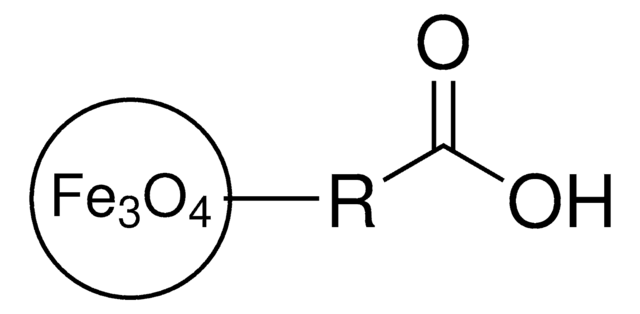725358
Iron oxide(II,III), magnetic nanoparticles solution
10 nm avg. part. size, 5 mg/mL in H2O
Synonym(s):
Magnetic iron oxide nanocrystals, Magnetite, Superparamagnetic iron oxide nanoparticles
About This Item
Recommended Products
form
dispersion
nanoparticles
concentration
5 mg/mL in H2O
magnetization
>45 emu/g, at 4500Oe
avg. part. size
10 nm
particle size
9-11 nm (TEM)
density
1.00 g/mL at 25 °C
SMILES string
O=[Fe].O=[Fe]O[Fe]=O
InChI
1S/3Fe.4O
InChI key
SZVJSHCCFOBDDC-UHFFFAOYSA-N
Looking for similar products? Visit Product Comparison Guide
Related Categories
General description
Application
- Optical resolution of ephedrine: A study explored the optical resolution of racemic ephedrine using various derivatives of tartaric acid, presenting a method that could refine the production of pharmaceutical-grade ephedrine hydrochloride (Bánhegyi et al., 2022).
- Stereoselective forensic analysis: Supercritical fluid chromatography coupled with tandem mass spectrometry was used to perform a stereoselective analysis of ephedrine and its isomers in seized methamphetamine samples, offering insights into forensic applications of ephedrine hydrochloride (Segawa et al., 2021).
- Chiral analysis of stimulants: A chiral high-performance liquid chromatography-tandem mass spectrometry method was applied to determine amphetamine-type stimulants, including ephedrine, in forensic samples, providing a tool for the precise separation and identification of chiral drugs (Schwelm et al., 2020).
Storage Class Code
12 - Non Combustible Liquids
WGK
nwg
Flash Point(F)
Not applicable
Flash Point(C)
Not applicable
Certificates of Analysis (COA)
Search for Certificates of Analysis (COA) by entering the products Lot/Batch Number. Lot and Batch Numbers can be found on a product’s label following the words ‘Lot’ or ‘Batch’.
Already Own This Product?
Find documentation for the products that you have recently purchased in the Document Library.
Customers Also Viewed
Articles
Explore DNA-functionalized nanoparticles in sensors for precise target analyte detection. Learn about types, synthesis, functionalization, and design optimization, with insights into challenges and prospects.
Explore DNA-functionalized nanoparticles in sensors for precise target analyte detection. Learn about types, synthesis, functionalization, and design optimization, with insights into challenges and prospects.
Explore DNA-functionalized nanoparticles in sensors for precise target analyte detection. Learn about types, synthesis, functionalization, and design optimization, with insights into challenges and prospects.
Explore DNA-functionalized nanoparticles in sensors for precise target analyte detection. Learn about types, synthesis, functionalization, and design optimization, with insights into challenges and prospects.
Our team of scientists has experience in all areas of research including Life Science, Material Science, Chemical Synthesis, Chromatography, Analytical and many others.
Contact Technical Service

